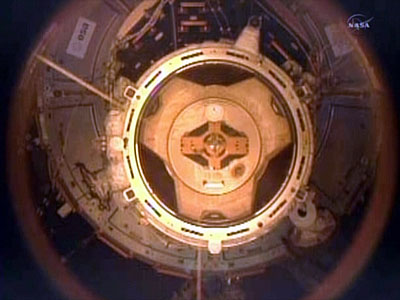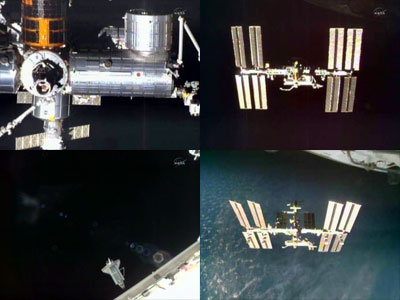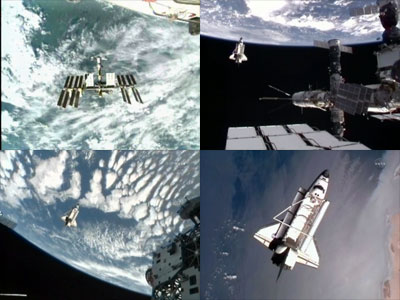|

|

FLIGHT DAY: Countdown • 1 • 2 • 3 • 4 • 5 • 6 • 7 • 8 • 9 • 10 • 11 • 12 • 13 • 14

Space, the final frontier... These have been the voyages of the space shuttle Discovery, its 30 year mission to seek out new science, to build new outposts, to bring nations together on the final frontier, to boldly go and do what no spacecraft has done before.
Discovery's STS-133 crew began their day at 2:23 a.m. CST to the voice of actor William Shatner, who played Star Trek's Captain James T. Kirk, narrating a special introduction to the Star Trek theme song as performed by Alexander Courage in honor of this being Discovery's final flight.
"I would like to thank specifically William Shatner for taking the time to record that special introduction for us," radioed Discovery's captain Steve Lindsey.
The "Theme from Star Trek" received the second most public votes from a Top 40 list as part of NASA's Space Rock wake-up song contest. The song received 671,134 votes out of the 2,463,774 ballots cast, or 27.2%.
It was a fitting beginning to the day that will see Discovery undock from the space station for the last time. Discovery was the first space shuttle to dock to the International Space Station, during the STS-96 mission in 1999, marking just one time it did what no spacecraft had done before.
Today's undocking is scheduled for 6 a.m. Afterward, pilot Eric Boe will fly the shuttle around the space station, allowing the shuttle crew to take photos of the ISS with its newest addition, the Permanent Multipurpose Module (PMM) Leonardo.
The fly around will begin at 6:29 a.m. When it is complete, Discovery will perform two engine firings, at 7:15 and 7:43 a.m. respectively, to begin increasing the distance between it and the space station.
The crew's afternoon will be devoted to a final inspection of Discovery's heat shield using the orbiter boom sensor system (OBSS) and its suite of cameras. The imagery collected during today's survey, which begins at 10:13 a.m., will be sent down for analysis on the ground to ensure that no damage has been done to Discovery while it has been in space.
|
The first spacecraft to dock with the International Space Station (ISS) in 1999, space shuttle Discovery departed the orbiting laboratory for a 13th and final time today.
STS-133 pilot Eric Boe took control of Discovery as it separated from the Pressurized Mating Adapter-2 (PMA-2) located on the forward port of the station's Harmony node. The spacecraft undocked at 6:00 a.m. CST on Monday, after eight days, 16 hours and 46 minutes being connected.
"Houston and Station, physical separation," radioed STS-133 commander Steven Lindsey.
"Discovery departing," announced Expedition 26 commander Scott Kelly, as he rung the station's ship bell, continuing a tradition borrowed from the Navy.

Credit: NASA TV
Discovery and the station were flying 220 miles over the Pacific Ocean, just to east of Indonesia and the north of Australia, at the time the orbiter unberthed.
Boe will fire Discovery's jets to separate the shuttle from the station to a distance of about 400 feet where he will begin a 360-degree flyaround of the orbiting laboratory.
Discovery has served a major role in the assembly of the space station. In addition to being the first spacecraft to dock to the burgeoning outpost, Discovery delivered Japan's Kibo pressurized module, the U.S. Harmony node, the first and several follow-on truss structures, and now on its final mission, the Permanent Multipurpose Module (PMM) Leonardo.
|
STS-133 pilot Eric Boe began guiding space shuttle Discovery through a fly around of the International Space Station at 6:23 a.m. CST, giving his five STS-133 crew mates the chance to visually survey the complex and the Permanent Multipurpose Module (PMM) Leonardo that they delivered and installed.
The fly around also provided the final views of Discovery flying in space, as captured by cameras on the station.


Credit: NASA TV
|
At 7:37 a.m. CST, Discovery fired its thrusters to complete its second of two engine burns, separating it from the International Space Station (ISS) and setting it on its course for a return to Earth on Wednesday.
After the first burn at 7:09 a.m., with the distance growing between their two vehicles, Expedition 26 commander Scott Kelly radioed Discovery to bid a final farewell.
"As you guys are heading home I wanted to say one last time that we really enjoyed your company on board," said Kelly. "I am really proud of what we accomplished together as a team here on the space station, but also including the larger team in Houston and all the control centers around the world."
"Doing something as complicated as this really takes a team effort and I think that's what we've proven here this last week. I'd like to wish you guys a safe rest of your flight and a safe landing," remarked Kelly.
"I couldn't agree more," replied STS-133 commander Steve Lindsey. "I think the team effort between our two crews and the larger ground team that planned this and put it all together, I think enabled us together to get well over 100 percent of our objectives. I don't know what percentage, but it was a lot more than we planned on doing."
"It's been a pleasure working with your team and look forward to seeing you guys. Have safe travels for everybody onboard," said Lindsey.
|
Flight Day Archive: Countdown • 1 • 2 • 3 • 4 • 5 • 6 • 7 • 8 • 9 • 10 • 11 • 12 • 13 • 14

© 2022 collectSPACE.com All rights reserved.
Questions? E-mail contact@collectspace.com
|
|
 advertisements advertisements
|
|




